Laid-back Suriname
Wooden houses, rivers, fortresses, old plantations and jungle
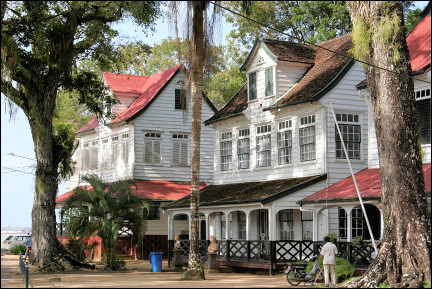
|
In the city center of Paramaribo there are old, white wooden houses, Fort Zeelandia, the presidential palace and a palm garden. A boat trip on the Suriname and the Commowijne rivers passes Fort New Amsterdam and old plantations. Going inland, in a small airplane, to Danpaati and other villages in the tropical rainforest around the Upper-Suriname river.
Travelogue & photos: Marianne Bekkering
On my arrival in Paramaribo in January, it's as if I am wrapped in a nice, warm blanket. It's not just the climate, but also the people. Everyone is friendly and laid back.
After breakfast in the garden of Hotel Torarica, accompanied by birds' twittering, we take a boat trip on the Suriname river. Usually the boat, the Bosrokoman, docks at the landing of the hotel, but it is currently under repair.
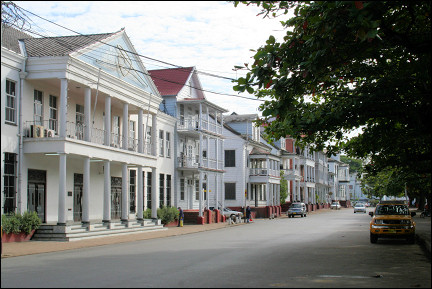
|
We have to walk to the "Waterkant" (Dutch for Waterfront), a beautiful part of the old city with white wooden houses. In colonial times, these houses belonged to plantation owners.
In 1821 almost the whole street burned down - in those days, there wasn't a fire department - but everything was rebuilt immediately. The Waterkant is one of the oldest streets of Paramaribo. Ships used to dock here.
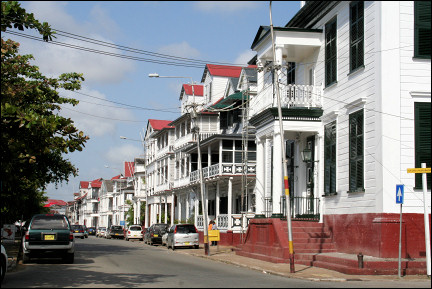
|
The historical part of the city, which was placed on the Unesco World Heritage List in 2002, is well-organized and everything is nearby.
Fort New Amsterdam and Frederiksdorp
Boat trip on the Suriname and Commowijne rivers
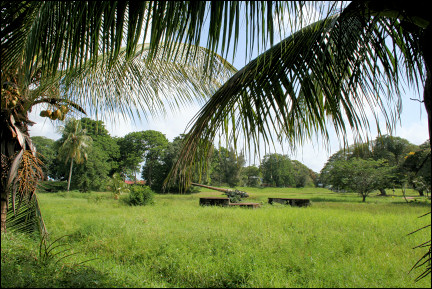
|
From the Waterkant, we sail to the 1747 Fort New Amsterdam. It's not a real fortress, but a pentagonal earthen wall with canons. It used to protect the plantations along the estuaries of the Suriname and Commowijne rivers.
Originally New Amsterdam was intended to become a stone fortress, but there were two obstacles. In the first place, the local clay is too wet and too salty to use for making bricks. That problem could be solved, but the ground was also too soft to build a heavy structure on. So it was decided to build instead five bastions surrounded by a star-shaped fortress with earthen walls.
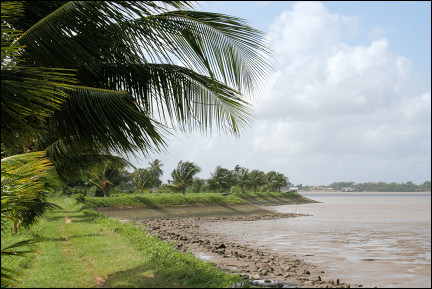
|
Fort New Amsterdam has an open-air museum with historical buidings, like an arsenal, officers' residences, a jail and a coach house with antique horse-drawn carriages.
The fortress is situated beautifully in a wonderful landscape at the spot where the Suriname and Commowijne rivers merge.
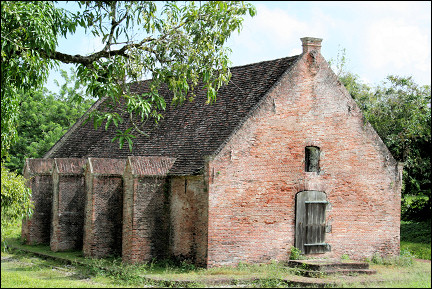
|
We get back on the boat and a little later we dock on the other side of the Commowijne river. We walk to the plantation Frederiksdorp. This former coffee plantation has been converted into a hotel by a Dutchman and his Surinameese wife.
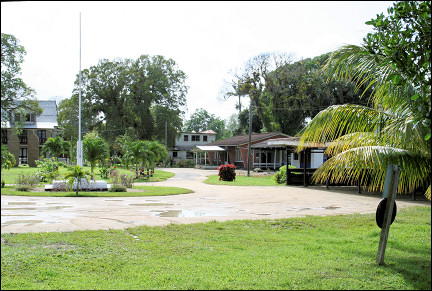
|
The historical buildings date from around 1760 and have been restored beautifully. I get a good impression of what a plantation must have looked like in the past. We have lunch at the plantation, which can only be reached by boat from Paramaribo.
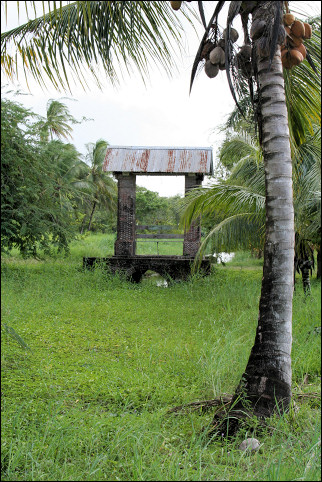
|
We return to the river, where the boat is waiting for us. The engine is switched off soon after we leave and we can take a swim in the river. We have to wear life jackets, because there is a strong current and it turns out not to be easy at all to stay near the boat.
We make a last stop at the plantation Rust en Werk ("Rest and Work"), wich sits on the right bank of the Lower Commowijne. This is a cattle breeding area and we see lots of cows grazing.
Nowadays there also are fish ponds in which shrimp are bred. Between everything else, there remains one old sluice.
We sail back to Paramaribo, where we dock again at the Waterkant near Fort Zeelandia.
City walk Paramaribo
In front of the palace songbirds show off their coloraturo
Next morning we take a guided city walk through the old, historical district of Paramaribo. Some building are beautifully renovated and look splendid, but many still are delapidated and desperately need a new coat of paint. In this damp, hot climate it's hard to keep things from falling apart. Still, it's apparently already better than a few years ago.
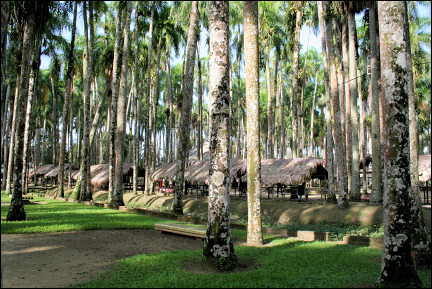
|
Via the palm garden (which used to be the back yard of the presidential palace, but is now open to the public) we walk to Fort Zeelandia, which we saw yesterday from the river.
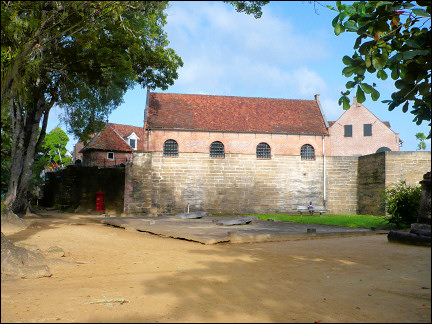
|
On the outside, Zeelandia is a pretty fortress, but smaller than I imagined. Today it's closed, so we have to come back some other time.
We walk to the Onafhankelijkheidsplein (Independence Square), where the presidential official residence is located. A pretty, bright-white building, 340 years old, with a colonade.
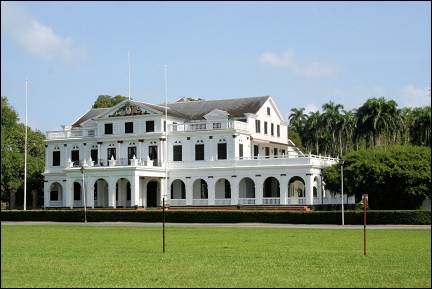
|
Early Sunday morning, men come to this square with their little songbirds, to show off their coloraturo. On the other side of the square is the Court of Justice.
We continue our walk to the St. Peter and Paul cathedral, which dates from 1884, and is located on the former Gravenstraat (now Henck Arronstraat). This cathedral is the largest wooden building in South America.
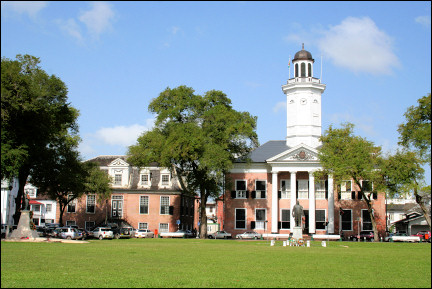
|
Unfortunately the cathedral is currently scaffolded, so we can't go inside. During an attempt at restoring the building in 1978, a supporting beam was sawed through, almost causing the collapse of the building. The building also has problems with termites. An extensive new restoration started in 2002.
We walk to the Dutch-Israelite synagogue, which is next door to the mosque. Something we can learn from. There seems to be more acceptance and tolerance between different religions here than in Holland.
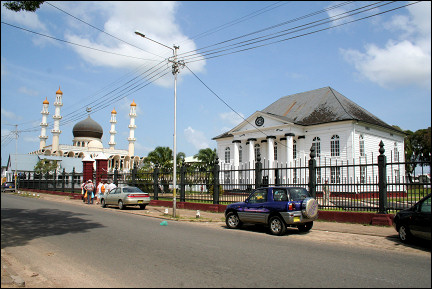
|
At 1 PM the city walk is over, it ends in the roti restaurant on the corner of Roopram, Mr. FHR. Lima Prostraat & De Watermolen. They serve superbly tasty rotis, so we recommend visiting here.
We spend the afternoon reading at the pool of the hotel and in the evening we pack our suitcase with only 5 kilos of stuff; we're not allowed to bring more on the little plane that will take us to Botopasi tomorrow. The rest of our things stay in the hotel until we return.
Danpaati River Lodge
An island in the Upper Suriname river
Next morning we leave for the airport where we will take a small plane to Botopasi. Before entering, everyone has to step on the scales with their luggage.
The safety belt is too wide for me, but the pilot has a solution: "Stay in Suriname a little longer and it will eventually fit."
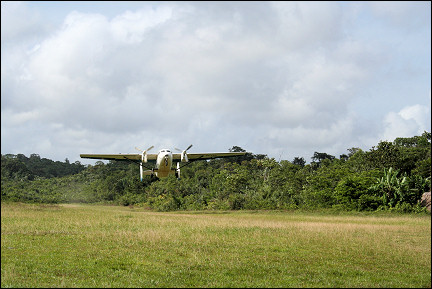
|
We fly in a cloudless sky, so we have a wonderful view of the broccoli field that is the rainforest from this height. We circle over Danpaati, of which we also have a great view. The female pilot reads the newspaper in the meantime.
After a little over half and hour we land in a meadow behind Botopasi, the plane leaves again immediately, a great sight with the forest in the background.
We walk through the village to two korjalen (canoes) which are waiting for us in the Upper Suriname river to take us to the Danpaati River Lodge. Unfortunately, it's only a 10 minutes trip. We sail on a beautiful, winding and wide river with on both sides dense tropical rainforest, which is part of the Amazon rainforest.
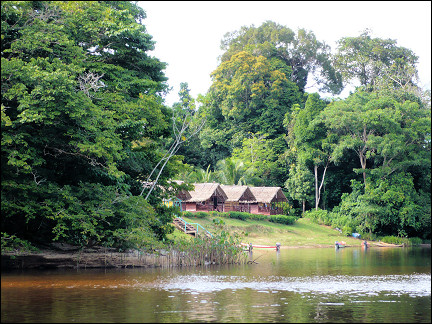
|
After the last bend we see the island Danpaati. It's a picture from a dream: wooden houses with palm-leave roofs, almost directly on the water, with in the background the dense, green forest.
It's a paradise on earth. Our house is on the water, from where we have a great view of the river, the rocks in it and the forest on the other side. The only thing we hear is the sound of silence, every now and then broken by bird sounds, the water and the canoes that pass by.
Danpaati River Lodge is a vacation village on an island in the Upper Suriname river. The lodge was also founded to support the local population. Many people from the village work in and for the lodge and the profit is used to finance a home-care project for the elderly in the 12 villages in the Saramaccan area around the island and eventually also for a day-care center.
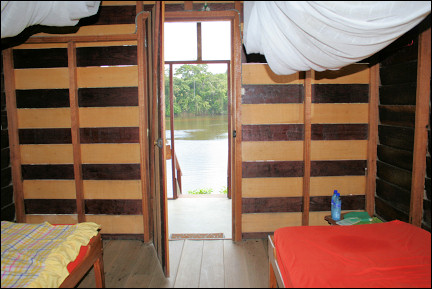
|
Especially elderly people have a hard life in the inland of Suriname. Young men often leave for Paramaribo to find jobs and young women often stay at their fields for days on end to grow vegetables.
The elderly and the children stay behind in their isolated villages without anyone to take care of them. The river - which is the center of social life in these villages - is hard to reach for the elderly: its banks are steep and have slippery stairs, hewn from the hard mud. For us it's already hard to descend, let alone for people in their eighties.

In every village, people are now trained in primary (health) care, like daily care of the old and the sick, washing, grooming, house cleaning, keeping the yard neat and keeping an eye on their health.
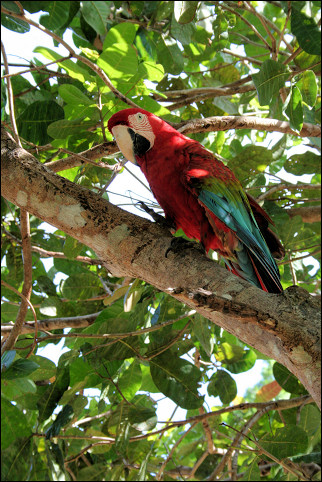
|
Staying at Danpaati River Lodge means that one not only has a great vacation in gorgeous natural surroundings, but one also supports the development of local health care. We stay for three nights, which actually isn't long enough.
The peace and quiet alone are reasons by themselves to visit here and we enjoy it fully. But we will have to postpone many trips to our next visit, like a trip to the Tapawatra waterfalls.
At 1 PM we have a communal lunch and later in the afternoon a local guide takes us on a tour of the island.
Later, I walk the same route by myself, with camera, to take pictures, among other things, of the tame ara which lives here.
We read and enjoy the wonderful view from our terrace. In the evening I take a few pictures of the rising moon and then there's another communal meal before we withdraw underneath the mosquito net.
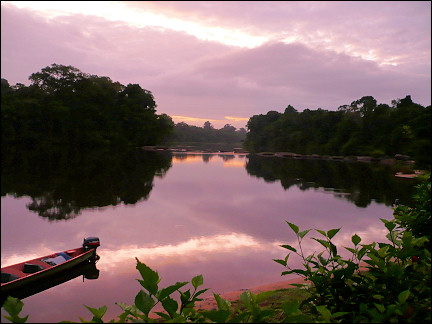
|
Next day we're outside already at 6 AM to see the day begin. Almost everyone is still asleep, so it's completely quiet.
The landscape slowly comes alive and colors from dark to light orange when the sun rises.
At this early hour, the birds are at their best and their songs fill the air. Early in the morning, a thermos with hot water and teabags are placed on one's terrace, so with all this enjoying one can also have a cup of tea. We automatically start to whisper, not to disturb this serene atmosphere.
Villages along the river
The population in this area speaks Saramaccan
Today we accompany a health worker to a village nearby. She is also our interpretor, because not many people here speak Dutch, like they do in Paramaribo.
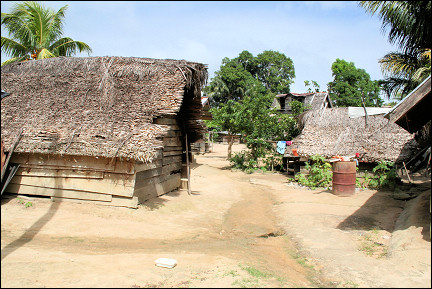
|
One of the workers didn't show up. We decide to help out and sweep the yard and do some laundry in the river, to solve the problem.
If you want to take pictures of people, of course you have to ask their permission first. I can take some pictures, on condition that I'll send them once we're back home.
The canoe takes us to the next village, where a day-care center and a school have been built. We take a look and then get back in the canoe, to return to Danpaati.
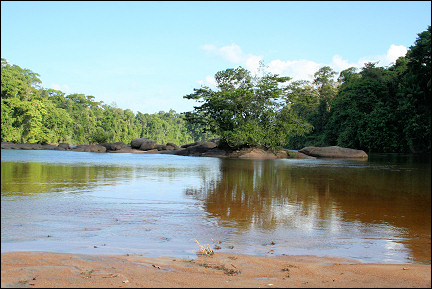
|
In the afternoon we go to the small beach on the south end of the island and take a swim and climb on the rocks in the middle of the river. One has a great view here.
The sky turns a leaden grey and there is a tropical rain shower. Time to wash my hair in the cold shower and then sit and read. This week, I don't read a lot, though: the view is too beautiful and there are interesting distractions, like a canoe passing by, or a boat full of children on their way to school.
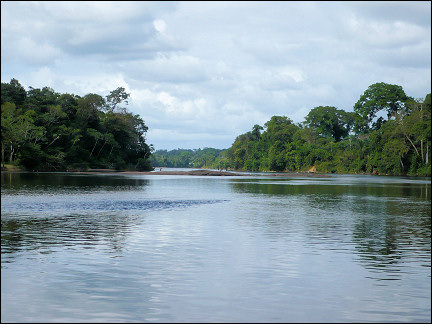
|
In the evening, there's a cultural song and dance show, performed by some ladies from Dan village, which lies on the bank opposite our island. The population in this region speaks Saramaccan. This is a Creole language, spoken by the Saramaccans, descendents of the Marrons, escaped West-African slaves.
Many plantation owners did not allow the slaves to speak with one another and in order to be able to communicate, people sang during labor. This way, they were able to transmit messages.
Forest walk
Many plants have medical and practical uses
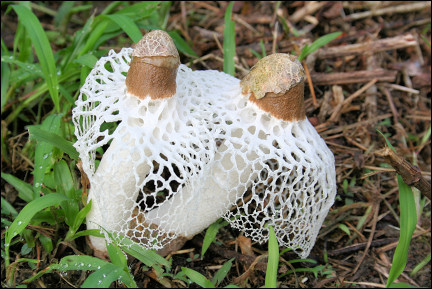
|
Next day we tour the island again to take pictures, like one of a gorgeous white mushroom with a kind of veil, aptly called veiled lady (Dictyophora Indusiata).
We sit at the north end of the island for a while, watching the rapids, the canoes that sail by and the women on the other side of the river, doing laundry.
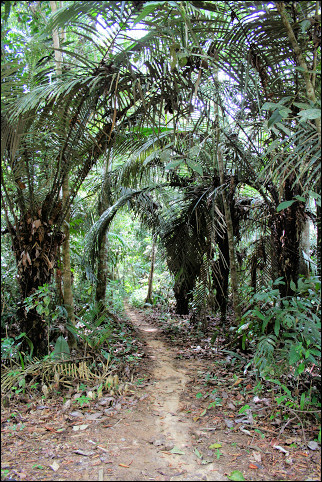
|
Later, on the beach at the other end of the island, we discover two pretty yellow brain fungi on a fallen-down tree. Beautifully yellow and rusty brown. They look like flowers.
In the afternoon a canoe takes us a few villages upstream, from where we'll begin our forest walk. With our guide Ronald, we walk back to Botopasi, where the canoe will pick us up. It's a wonderful, three-hours walk on well-passable paths.
On the way, Ronald tells us about the plants we see, both medical and practical information. There is the "noise tree": if you've lost your way, you can beat on it with a stick and the sound it makes is loud enough for others to find you. It's also convenient to know which fruits one can eat while waiting to be found.
In the evening Paul Middellijn visits the lodge; he lives in Rotterdam, Holland, and is a descendent from a family of Surinameese storytellers. In 1994 he founded the Tori Academia (Story Acadamy), which now has branches in Rotterdam, Antwerp (Belgium) and Paramaribo, the capital of Suriname.
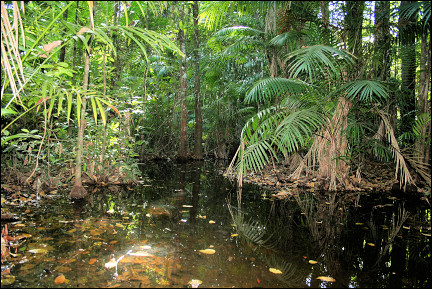
|
Only a few oil lamps burn when Paul begins to tell stories. I was looking forward to this anyway, but in this setting it's even more fun. A wonderful end of our stay on the island, because Paul is an excellent storyteller. We are in luck that he is here, because his performance here is not part of the routine.
Paramaribo
There is a large market along the water
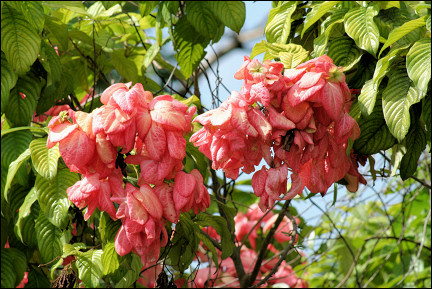
|
On our last morning here, we again sit on our terrace early in the morning to see the day begin. It gets light slowly and from the other side of the river come the sounds of a lone howler monkey and birds. Every now and then we see a circle on the water, a sign that a fish or a small cayman swims there.
After an early breakfast we get in the canoe which takes us to Botopasi. There we get on the plane that takes us back to Paramaribo. Again, the views of the landscape from the sky are stunning.
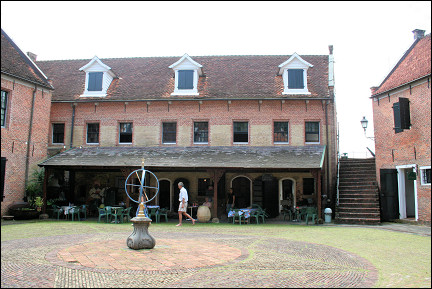
|
In Paramaribo we visit Fort Zeelandia, which is open now. It is a pretty fortress, but it has a gruesome recent history: during the military dictatorship of Col. Desi Bouterse, the so-called "December murders" took place here, in which 15 intellectuals, journalists and union leaders where tortured and killed.
The fortress is a museum now and we pay an extensive visit to its exhibition.
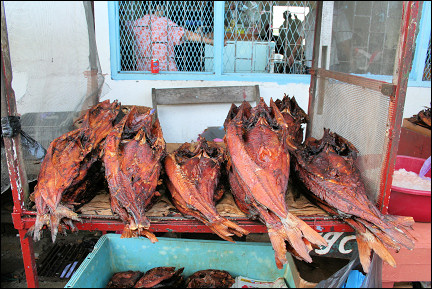
|
On our last day in this wonderful country we wake up early, even though we were talking on our terrace until late yesterday. We have a cup of tea and then leave for an early visit to the big market along the water. It's still quiet en we take the opportunity to chat with the vendors.
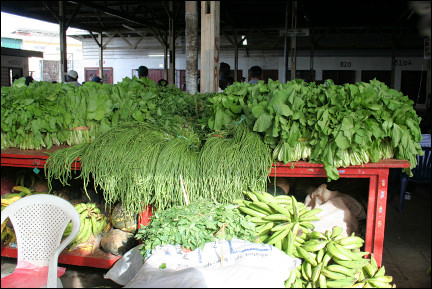
|
We wander around for a while. I buy a pretty piece of fabric and then we return to the hotel for breakfast. We stay at the pool to read.
At noon we have to shower, because 1 PM is check-out time. Unfortunately, our vacation is over. But we decide to come back soon and stay longer.